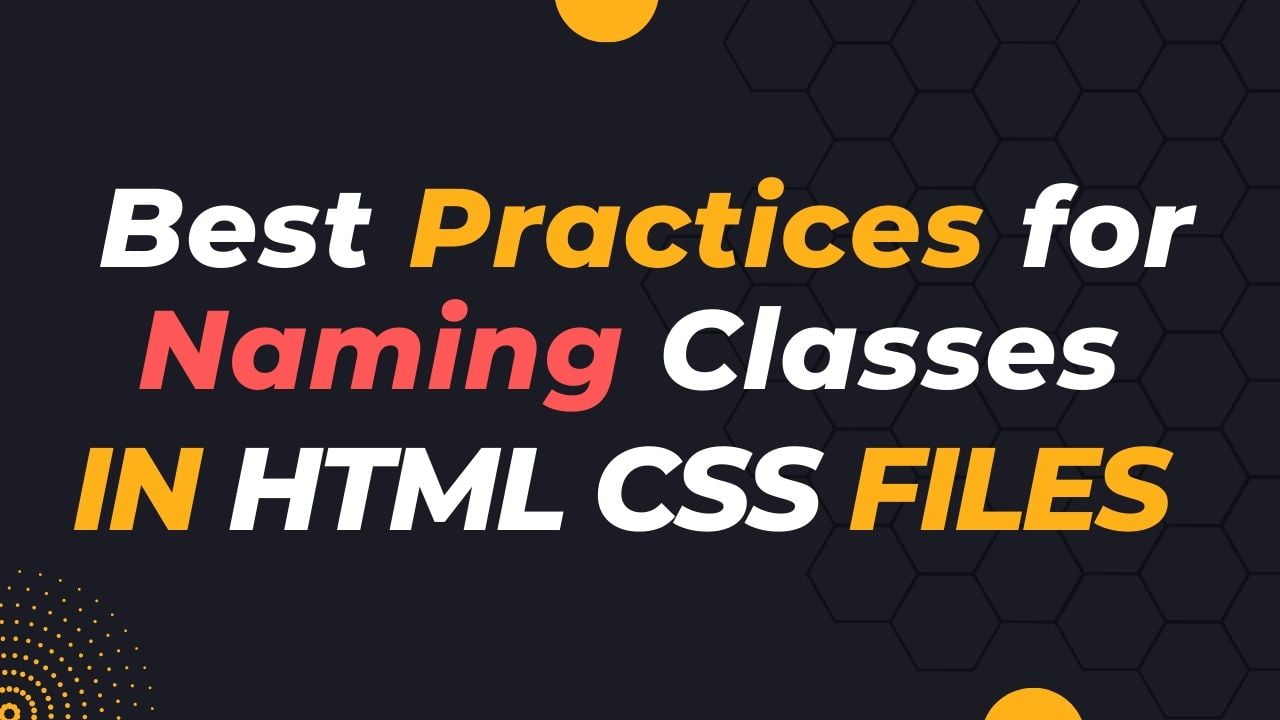In this article, we’ll delve into the Best Practices for Naming Classes in HTML CSS Files to help you write more efficient and organized code. When it comes to developing clean and maintainable HTML and CSS code, one of the fundamental aspects is selecting appropriate class names. Properly named classes not only enhance the readability of your code but also play a crucial role in promoting consistency and scalability within your projects.
📌 Be Descriptive and Intentional Best Practices for Naming Classes
<!-- Bad Example -->
<button class="s">Submit</button>
<nav class="nav">...</nav>
<!-- Good Example -->
<button class="submit-button">Submit</button>
<nav class="navigation-bar">...</nav>
Class names should be descriptive and convey the purpose of the element they represent. Aim for clarity and avoid using vague or overly generic names. Instead of using single-letter or abbreviated names like “s”, “btn”, or “div”, opt for more meaningful and explicit names that reflect the element’s role in the document. For instance, “submit-button” or “navigation-bar” provides more context and clarity than “btn” or “nav.”
📌Use Semantic Best Practices for Naming Classes
<!-- Bad Example -->
<div class="section1">...</div>
<div class="content_area">...</div>
<!-- Good Example -->
<section class="header">...</section>
<section class="article">...</section>
While it's essential to be descriptive, overly long class names can lead to cumbersome code and decrease readability. Aim for a balance by keeping class names concise while still conveying their purpose. A good practice is to use single words or short phrases that succinctly define the element.
📌 Be Mindful of Scope Best Practices for Naming Classes
When working on larger projects or collaborating with other developers, be mindful of the scope of your class names. Avoid generic names that might clash with other components or libraries. Consider using a prefix unique to your project to minimize the risk of naming conflicts.
<!-- Bad Example (Potential naming conflict) -->
<div class="sidebar">...</div>
<div class="sidebar">...</div>
<!-- Good Example (Using project-specific prefix) -->
<div class="project-sidebar">...</div>
<div class="project-content">...</div>
📌 Follow a Consistent Naming Convention Best Practices for Naming Classes
<!-- BEM Convention -->
<article class="block">
<h1 class="block__title">...</h1>
<p class="block__content">...</p>
</article>
<!-- SMACSS Convention -->
<section class="main">
<header class="main-header">...</header>
<nav class="main-nav">...</nav>
</section>
Stick to a naming convention for better code organization and consistency.
Popular conventions include BEM (Block, Element, Modifier) and SMACSS (Scalable and Modular Architecture for CSS).📌 Avoid Presentational or Styling Names
Class names should focus on describing the element’s purpose and not its presentation or style. Avoid naming classes based on visual properties like color, font-size, or alignment, as these may change over time. Separating structure from presentation helps in keeping your CSS modular and improves code reusability.
<!-- Bad Example -->
<h3 class="red-text">...</h3>
<p class="large-font">...</p>
<!-- Good Example -->
<h3 class="section-title">...</h3>
<p class="paragraph">...</p>
📌 Use Short and Meaningful Class Names
<!-- Bad Example -->
<div class="navigation-container">...</div>
<button class="large-green-button">Submit</button>
<!-- Good Example -->
<div class="nav-container">...</div>
<button class="submit-btn">Submit</button>
While it’s essential to be descriptive, overly long class names can lead to cumbersome code and decrease readability. Aim for a balance by keeping class names concise while still conveying their purpose. A good practice is to use single words or short phrases that succinctly define the element.
📌 Avoid Inline Styling Best Practices for Naming Classes
Although it’s not directly related to class naming, it’s worth mentioning that inline styles should be avoided in HTML files. Instead, define styles in your CSS files and refer to them via class names. This separation of concerns promotes maintainability and improves code organization.
Conclusion:
Selecting appropriate class names is a crucial aspect of writing clean and maintainable HTML and CSS Best Practices for Naming Classescode. By following best practices such as being descriptive, using semantic naming, adhering to a consistent convention, and avoiding presentational names, you can significantly enhance your codebase. Remember, clear and intentional class names not only benefit you as the developer but also contribute to improved collaboration and project scalability. By investing time in selecting the right class names, you set the foundation for a more robust and efficient front-end development process.
Remember, incorporating these best practices with meaningful and consistent class names in your HTML and CSS files will contribute to cleaner, more maintainable, and easily understandable code. Happy coding! 💻🎨🚀
Here more another important and new blog




One thought on “Best Practices for Naming Classes in HTML CSS Files”